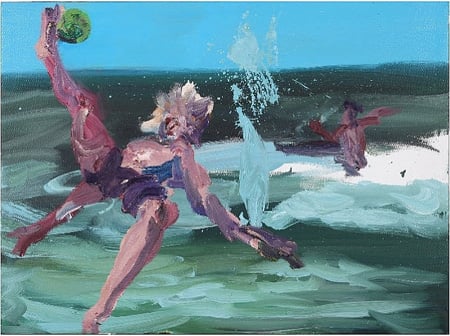
Rainer Fetting, Ballspiel am Meer, 2010, Galerie Deschler
Welcome to our first article in the German glossary series. In this series we will focus on Germany, a country known for its famous painters, musicians, philosophers, and writers.
Since its inception in 1955 by renowned artist Arnold Bode (German, 1900–1977), documenta has made Germany a key player in the art world. documenta is one of the largest exhibitions of Modern and Contemporary Art in the world, and takes place every five years in Kassel, Germany. The exhibition lasts for 100 days, which is why it is often referred to as the “museum of 100 days.”
CONTEMPORARY ART TERMINOLOGY A–Z:
| Abstract Expressionism | Abstrakter Expressionismus |
| CoBrA | CoBrA |
| Color Field Painting | Farbfeldmalerei |
| Conceptual Art | Konzeptkunst |
| Contemporary Art | Zeitgenössische Kunst |
| Digital Art | Digitale Kunst |
| Feminist Art | Feministische Kunst |
| Free Figuration | Freie Figuration |
| Graffiti Art | Graffiti |
| Happening | Happening |
| Hyperrealism | Hyperrealismus |
| Impressionism | Impressionismus |
| Informal Art | Informel |
| Kinetic Art | Kinetik |
| Land Art | Land Art |
| Minimalism | Minimalismus |
| Modern Art | Moderne Kunst |
| Narrative Figuration | Narrative Figuration |
| Neo-Dada | Neodada |
| New Objectivity | Neue Sachlichkeit |
| New Realism | Neuer Realismus |
| New York School | New York School |
| Op Art | Op Art |
| Photography | Fotografie |
| Photorealism | Fotorealismus |
| Pop Art | Pop Art |
| Surrealism | Surrealismus |
| Urban Art | Urban Art |
Gerhard Richter, Fuji 839-16, 1996, Galerie Ludorff
A SELECTION OF CONTEMPORARY ART MUSEUMS IN GERMANY
Goetz Collection (Sammlung Goetz)
- About: Located in Munich, the Goetz Collection is the largest private collection of Contemporary Art in Germany. Ingvild Goetz began collecting art in the mid-1980s, and since then, her collection has evolved to include works by some of the most well-known artists of the Arte Povera movement. The museum also has a newly redesigned theater, which features art-house films and other multimedia work.
- Did you know? The building that houses the Goetz Collection was built by the Swiss architecture firm Herzog & de Meuron.
- Address: Oberföhringer Straße 103, 81925 Munich, Germany
- Website: http://www.sammlung-goetz.de/en
- Hours: 2 p.m.–6 p.m., Thursday through Friday; and 11 a.m.–4 p.m., Saturday
Haus der Kunst
- About: Haus der Kunst is a non-collecting art museum, focused on Contemporary exhibitions. The museum explores the histories of the different forms of Contemporary Art through exhibitions, research, and educational programs.
- Did you know? During the 2006 FIFA World Cup, Haus der Kunst played host to the Allianz Arena sign because, according to FIFA regulations, stadiums are not allowed to display a sponsor’s name unless they are an official tournament partner.
- Address: Prinzregentenstraße 1, 80538 Munich, Germany
- Website: http://www.hausderkunst.de/index.php?id=1&L=1
- Hours: 10 a.m.–8 p.m., Monday through Sunday; and 10 a.m.–10 p.m., Thursday
Berlinische Galerie—Museum of Modern Art
- About: This museum of Modern Art, architecture, and photography is one of the youngest exhibition centers in Germany’s capital. The collection consists of Berlin art dating from 1870 to the present, and a range of international and local artwork, from Dada and the Neue Sachlichkeit (New Objectivity), to Eastern European avant-garde art.
- Did you know? Every first Monday of the month, admission is just €4.
- Address: Alte Jakobstraße 124-128, 10969 Berlin, Germany
- Website: http://www.berlinischegalerie.de/en/home/
- Hours: 10 a.m.–6 p.m., Monday and Wednesday through Sunday
Schirn Kunsthalle Frankfurt
- About: Schirn Kunsthalle Frankfurt is one of the most popular Contemporary Art galleries in Germany. The venue hosts temporary exhibitions, which have included recent retrospectives for artists such as Frida Kahlo (Mexican, 1907–1954) and Marc Chagall (French/Russian, 1887–1955). The gallery is also well-known for curating shows with highly charged themes in the hopes of opening up new conversations about art’s role in society.
- Did you know? Schirn Kunsthalle Frankfurt has held over 200 exhibitions on a wide range of subjects, including Art Nouveau, Dada, Surrealism, and Impressionism.
- Address: Römerberg, 60311 Frankfurt am Main, Germany
- Website: http://www.schirn.de/en/Home.html
- Hours: 10 a.m.–7 p.m., Tuesday and Friday through Sunday; and 10 a.m.–10 p.m., Wednesday and Thursday
Deichtorhallen Hamburg
- About: Deichtorhallen Hamburg is one of Europe’s largest exhibition centers for Contemporary Art and photography. The space is comprised of two buildings dating from 1911–1913, and plays host to major international shows.
- Did you know? In 1911, the Deichtorhallen were built as market halls, and their open steel structures are some of the only remaining examples of the transitional architectural style that characterized early 20th-century design.
- Address: Deichtorstraße 1-2, 20095 Hamburg, Germany
- Website: http://www.deichtorhallen.de/index.php?id=5&L=1
- Hours: 11 a.m.–6 p.m., Tuesday through Sunday; and 11 a.m.–9 p.m., every first Thursday of the month
Museum Folkwang
- About: Museum Folkwang is one of the most famous art museums in Germany, with a wide-ranging collection that includes 19th century sculpture and painting, as well as photography. In addition to the permanent collection, the museum also hosts a number of special exhibitions throughout the year.
- Did you know? The collection of paintings includes nearly 600 Modern and Contemporary artworks. It also houses the Deutsche Plakat Museum (German Poster Museum), which contains approximately 340,000 political, economic, and cultural works.
- Address: Museumsplatz 1, 45128 Essen, Germany
- Website: http://www.museum-folkwang.de/en/museum-folkwang.html
- Hours: 10 a.m.–6 p.m., Tuesday through Sunday; and 10 a.m.–10:30 p.m., Friday